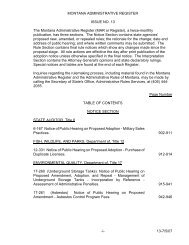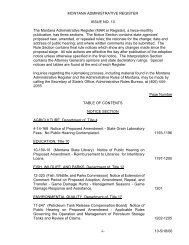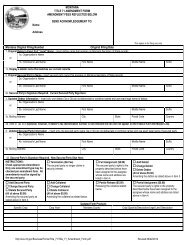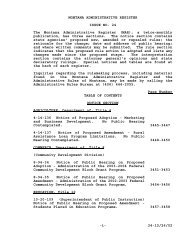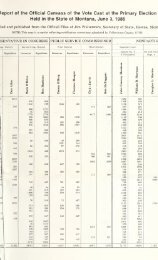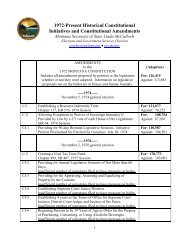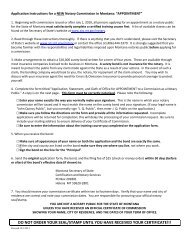Issue 3 - the Montana Secretary of State Website
Issue 3 - the Montana Secretary of State Website
Issue 3 - the Montana Secretary of State Website
You also want an ePaper? Increase the reach of your titles
YUMPU automatically turns print PDFs into web optimized ePapers that Google loves.
-387-<br />
scientific studies. Sen. Keating opposed <strong>the</strong> motion on <strong>the</strong> ground that "this bill<br />
doesn't say you have to have a peer-reviewed study, it only says you review any<br />
studies contained in <strong>the</strong> record that form <strong>the</strong> basis for <strong>the</strong> board's conclusion [sic]<br />
and 'if any' doesn't add anything." Sen. Grosfield <strong>the</strong>n indicated that he thought that<br />
<strong>the</strong> bill could be interpreted that way, but "if it is clear to <strong>the</strong> committee that <strong>the</strong> bill<br />
will not require peer-reviewed studies," it was okay with him and he would withdraw<br />
<strong>the</strong> pertinent amendments. He <strong>the</strong>n withdrew <strong>the</strong> amendments.<br />
In addition, <strong>the</strong> preamble to HB 521 provides that <strong>the</strong> written finding "must<br />
include but is not limited to a discussion <strong>of</strong> <strong>the</strong> policy reasons and an analysis that<br />
supports <strong>the</strong> board's or <strong>the</strong> department's decision that <strong>the</strong> proposed state standards<br />
or requirements protect public health or <strong>the</strong> environment <strong>of</strong> <strong>the</strong> state and that <strong>the</strong><br />
state standards or requirements protect public health and are achievable under<br />
current technology." The preamble contains no reference to peer-reviewed scientific<br />
studies.<br />
Given <strong>the</strong> statements from <strong>the</strong> legislative history and <strong>the</strong> language <strong>of</strong> <strong>the</strong><br />
preamble, it is <strong>the</strong> department's opinion that citation to peer-reviewed scientific<br />
studies in <strong>the</strong> record is not a prerequisite to adoption <strong>of</strong> a rule that is more stringent<br />
than a comparable federal regulation or guideline. Ra<strong>the</strong>r, a written finding required<br />
by HB 521 must reference peer-reviewed scientific studies if <strong>the</strong> rulemaking record<br />
contains <strong>the</strong>m.<br />
In addition, <strong>the</strong> department introduced into <strong>the</strong> record language from EPA<br />
rulemakings concerning <strong>the</strong> regulations that <strong>the</strong> commentor alleges are less<br />
stringent. It is clear that EPA contemplated that states would have flexibility in<br />
implementing <strong>the</strong> licensing and oversight <strong>of</strong> regulation <strong>of</strong> solid waste landfills.<br />
COMMENT NO. 71: A commentor stated that <strong>the</strong> department's analysis <strong>of</strong><br />
<strong>the</strong> actual breadth <strong>of</strong> <strong>the</strong> requirements <strong>of</strong> <strong>the</strong> federal regulations found in 40 CFR<br />
Parts 257 and 258 misrepresents <strong>the</strong> flexibility granted to states by EPA and is<br />
fatally flawed. EPA allows states flexibility only to have programs that are more<br />
stringent than minimum EPA requirements. Because 40 CFR Part 258 is designed<br />
to be self-implementing, most <strong>of</strong> <strong>the</strong> flexibility <strong>of</strong>fered to states concerns items that<br />
facilities would desire, such as approval to use multi-unit groundwater monitoring<br />
arrays ra<strong>the</strong>r than monitoring each unit individually and such as approval to locate a<br />
landfill in a seismically active area.<br />
RESPONSE: Because <strong>the</strong> commentor did not identify a specific rule where<br />
<strong>the</strong> department had misrepresented <strong>the</strong> flexibility granted to states by EPA, <strong>the</strong><br />
department will provide a general response. The department believes <strong>the</strong><br />
stringency analysis and findings were capably prepared and adequately address <strong>the</strong><br />
applicable elements <strong>of</strong> 75-10-107, MCA. In addition, <strong>the</strong> department believes that<br />
<strong>the</strong> commentor has misstated EPA's regulatory approach in creating <strong>the</strong> federal<br />
regulations and in approving state programs. The regulations proposed in 1988<br />
were, to some degree, based on state implementation. Concerns raised by<br />
regulated entities and state governments in comments on <strong>the</strong> proposed regulations<br />
led EPA to adopt regulations in 1991 that emphasized a self-implementing<br />
approach, so as not to delay <strong>the</strong> effect <strong>of</strong> regulatory requirements such as a landfill<br />
owner's duty to respond to ground water contamination by taking action when a<br />
state might not yet have <strong>the</strong> capacity to review <strong>the</strong> contamination and require action.<br />
3-2/11/10 <strong>Montana</strong> Administrative Register




